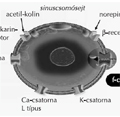The eLitMed.hu medical portal uses computer cookies for convenient operation. Detailed information can be found in the Cookie-policy.
Lege Artis Medicinae - 2007;17(01 klsz)
Content
[THE ROLE OF METABOLIC THERAPY IN THE TREATMENT OF STABLE RECURRENT ANGINA AFTER CORONARY REVASCULARIZATION]
[Current guidelines recommend drug treatment as firstline therapy for stable angina. If adequate symptom relief cannot be achieved with pharmacological management, or if myocardial ischaemia progresses, interventional revascularization procedures should be considered. Based on current guidelines, this should be either coronary artery bypass grafting or percutaneous coronary intervention. Recurrent angina refers to the persistence or reemergence of angina symptoms after a coronary revascularization procedure. This clinical situation indicates the repeat of coronarography as soon as possible. The repeated coronarography, however, often will not confirm progression or restenosis. The pathology of this clinical form of recurrent angina is not exactly known. As symptoms are frequently seen in the absence of abnormal coronary blood flow, vasodilator drugs are of limited effectiveness in recurrent angina. For this reason new, non-haemodynamic treatment approaches have been suggested. Among these, agents that help optimise cardiac metabolism are of particular interest. Trimetazidine acts on the energy metabolism of myocardial cells by reducing the reliance of myocardial metabolism on fatty acid oxidation and lifting the feedback inhibition of the glucose oxidation pathway. Moreover, trimetazidine reduces intracellular acidosis. These beneficial effects on cellular processes make trimetazidine the first representative of cardioprotective drugs. In randomized, placebo-controlled clinical trials on patients after revascularization, trimetazidine significantly reduced the number of angina episodes, decreased the ECG signs and the levels of biochemical markers of myocardial ischaemia, and improved exercise test parameters compared to placebo. The spectrum of benefits of this drug in stable angina ranges from decreasing the need for surgical intervention to improving the outcome and diminishing the symptoms of angina pectoris following revascularization.]
[ELEVATED RESTING HEART RATE AND THE RISK OF CARDIOVASCULAR MORTALITY]
[In ancient times medical practitioners already knew that heart rate is a measure of the general condition of the soul and body. Worldwide epidemiologic studies in the past decades indicated that decreased resting heart rate, a parameter that can be simply measured, has a favourable direct effect on cardiovascular risk. This consistent beneficial risk-reducing effect can be clearly shown in the asymptomatic general population as well as in patients with hypertension, stable coronary artery disease, acute myocardial infarction and congestive heart failure irrespective of gender, age or ethnic origin. In the asymptomatic general population this beneficial effect is mainly due to reduced early coronary artery disease events and diminished risk of sudden cardiac death. Population studies have clearly shown that decreasing resting heart rate - either by physical exercise or medical treatment - improves cardiovascular survival, and decreases the overall and cardiovascular mortality. It seems reasonable to conclude that in modern pharmacotherapy of cardiovascular disease the use of selective heart rate lowering drugs that directly act on the pacemaker activity of the sinus node (If-channel blockers) are warranted.]
[If-CHANNEL INHIBITION - A NEW APPROACH IN THE TREATMENT OF ISCHAEMIC HEART DISEASE]
[Life span, body mass and metabolic rate are strongly related to resting heart rate. Several studies suggest that the reduction of heart rate has a beneficial effect on cardiac morbidity and mortality. Ivabradine, the first selective and specific If- channel inhibitor, has a novel and unique mode of action on cardiac pacemaker activity. It acts at the core of heart rate regulation by specifically binding to the f-channel of the sinus node cell and selectively inhibiting the If (funny) current. Praeclinical studies have convincingly proved that this drug reduces heart rate without any adverse electrophysiologic or haemodynamic side effects.]
1.
Clinical Neuroscience
[Headache registry in Szeged: Experiences regarding to migraine patients]2.
Clinical Neuroscience
[The new target population of stroke awareness campaign: Kindergarten students ]3.
Clinical Neuroscience
Is there any difference in mortality rates of atrial fibrillation detected before or after ischemic stroke?4.
Clinical Neuroscience
Factors influencing the level of stigma in Parkinson’s disease in western Turkey5.
Clinical Neuroscience
[The effects of demographic and clinical factors on the severity of poststroke aphasia]1.
2.
Clinical Oncology
[Pancreatic cancer: ESMO Clinical Practice Guideline for diagnosis, treatment and follow-up]3.
Clinical Oncology
[Pharmacovigilance landscape – Lessons from the past and opportunities for future]4.
5.






